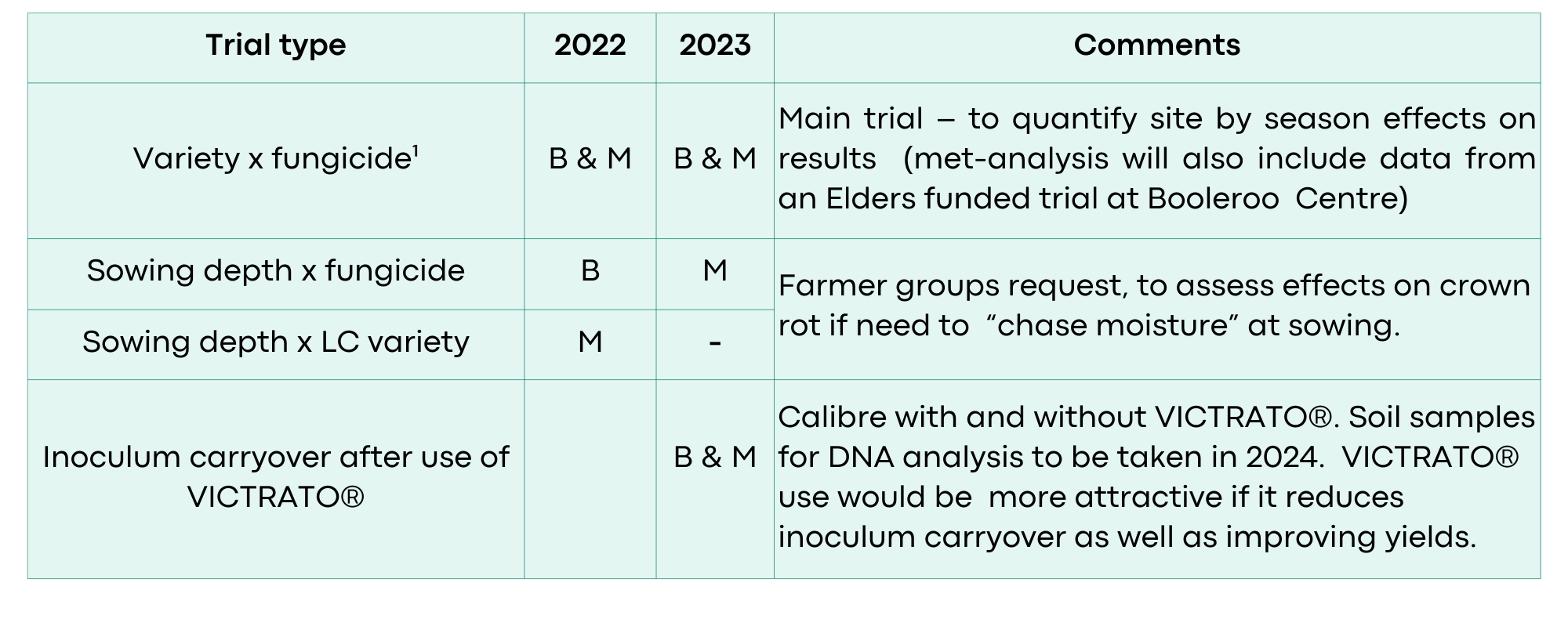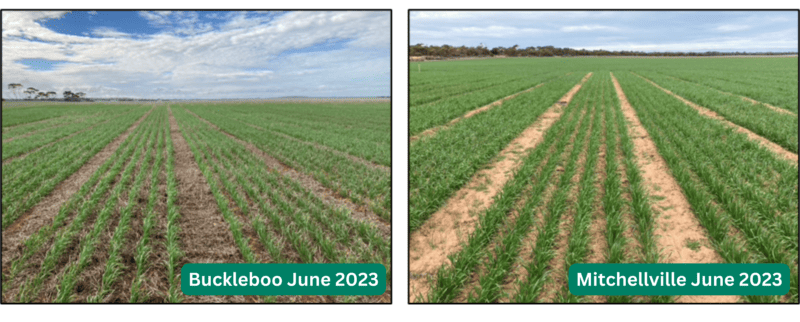Managing crown rot on Upper Eyre Peninsula – a joint learning experience
Crown rot management trials funded by SAGIT were planned in collaboration with farmer groups at Mitchellville (Franklin Harbour Agricultural Bureau) and Buckleboo (Buckleboo Farm Improvement Group). Plans include assessing how depth of sowing, varietal maturity and resistance to crown rot influence crown rot expression, yield and grain quality with and without fungicide seed treatment. VICTRATO® (with TYMIRIUM® chemistry) fungicide seed treatment is a Syngenta product proposed for commercial release in Australia in 2024 to assist with reducing yield losses due to crown rot.
Trial program
Sites with medium to high crown rot risk levels were selected at Buckleboo (B) and Mitchellville (M) in 2022 and again in 2023, with trials as described below.
 Varieties used in all main trials were selected to have a range of maturities and crown rot susceptibilities. Bread wheat varieties were:
Varieties used in all main trials were selected to have a range of maturities and crown rot susceptibilities. Bread wheat varieties were:
- Emu Rock (very quick to quick maturing; MSS);
- Trojan – in 2023 only (mid to slow maturing; MS);
- Vixen (quick maturing; S);
- Calibre (quick to mid maturing; S);
- Razor (quick to mid maturing; IMI tolerant; S);
- Scepter (mid maturing; S).
- One barley variety Commodus – quick to mid maturing; escapes yield losses due to crown rot, was also included in main trials.
2022 Summary
Sub-soil moisture at sowing was high, seasonal rainfall was above average and there were mild conditions during flowering and grain filling. This resulted in good yields at both sites, with average Calibre yields at Buckleboo of 3.45 t/ha and at Mitchellville of 2.90 t/ha. Crown rot pressure was limited and, despite high visual incidence on main stem bases (72%-100%), the severity of expression was low, with main stem browning scores of 0.82-2.84 (average = 1.82). Yield losses due to crown rot usually start at a score of around 2.50.
Yield responses in main trials:
On average, where VICTRATO® seed dressing was applied there were yield improvements of 7% (0.19 t/ha) at Mitchellville and 5% (0.20 t/ha) at Buckleboo. There was variation in % yield improvements amongst plots, indicating responses across paddocks will also vary. These findings are consistent with those from trials in previous years at medium rainfall sites.
There were no significant variety by VICTRATO® interactions for yield, implying that percentage yield improvements will be similar for bread wheat varieties and, perhaps, for barley varieties. If this response is consistent across seasons as well as sites, this will simplify on-farm decision making with respect to using VICTRATO® for managing crown rot.
Crown rot responses in main trials:
Visual incidence and severity of crown rot on main stems at early grain filling was lower in VICTRATO® treated than in untreated plots at both sites. Differences were not large, but were more pronounced at Mitchellville – decrease in incidence from 97% to 87% and in severity from 2.15 to 1.55.
The implication is that VICTRATO® may influence both the level of infection and the rate of growth of crown rot through the plant. Reductions were only slight in a year of low crown rot pressure, but in years of high pressure the influence could be much greater.
Sowing depth effects (with and without VICTRATO®):
There were no significant treatment effects on yield of Calibre or on visual incidence of crown rot. Crown rot severity (main stem score) was lower in VICTRATO® treated (av. 1.16) than in untreated (av. 1.38) plots. There was no effect of sowing depth on crown rot severity.
2023
Trials and demonstration areas (photos below) were sown at Mitchellville (4 May) and Buckleboo (2 May). While soil moisture was a little lower than ideal at sowing, rain shortly afterwards resulted in good plant emergence and establishment.
Buckleboo: the trial paddock is managed under a strip and disc system and has a high stubble load. Stubble in the trial area was mulched to allow tine sowing with the plot seeder.
Mitchellville: paddocks on this property are often disc ploughed over summer to assist with crown rot management and for this reason stubble is not visible at the trial site despite a medium risk of yield loss due to crown rot being present.

The sites will be visited at during spring crop walks (BFIG on 30 August, Franklin Harbour in September, date to be confirmed) and final results will be published early 2024.
For more information on this project please visit the AIR EP website by clicking here

